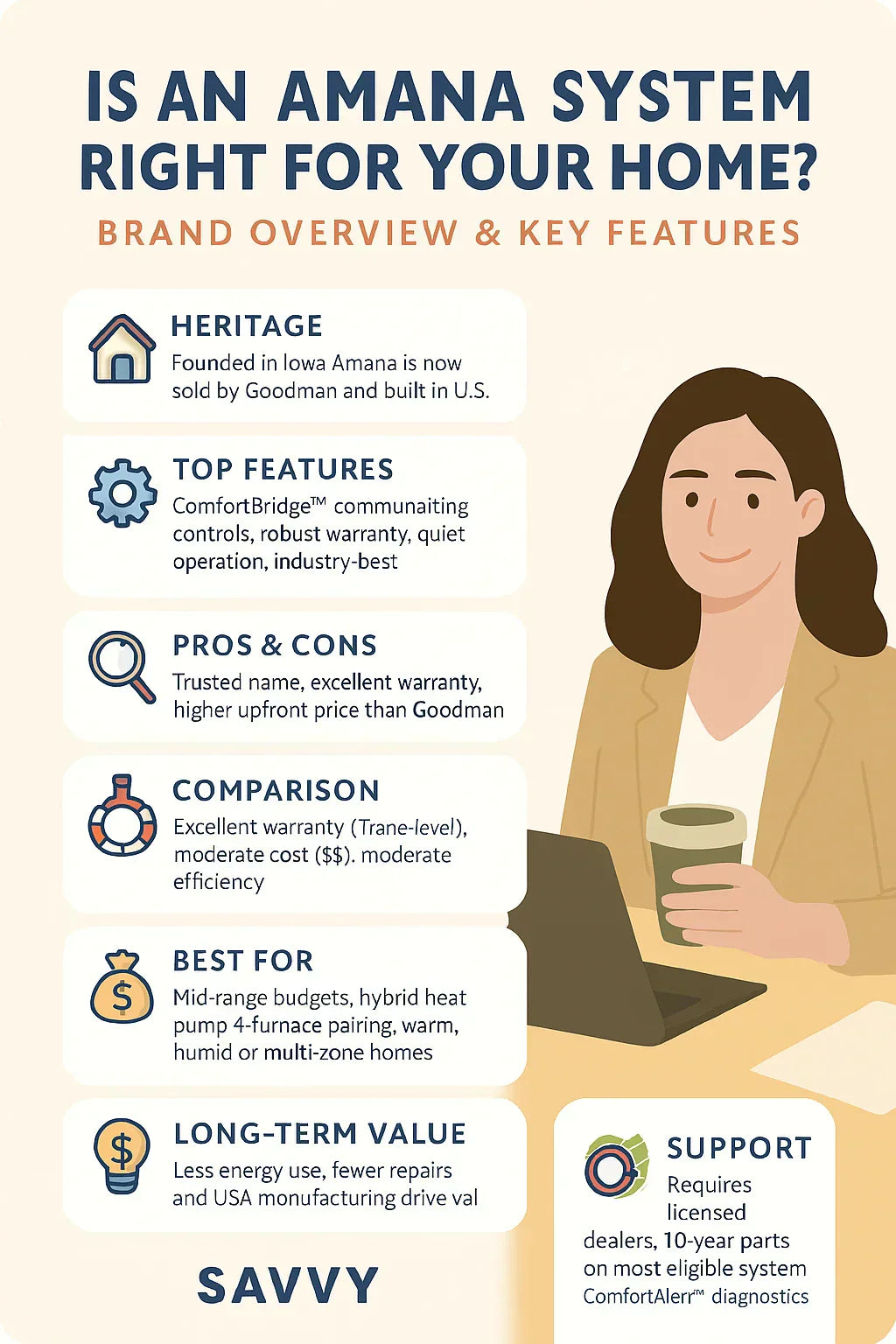📋 Introduction
If you’re shopping for a new heating or cooling system, you’ve probably come across the Amana name. Known for combining American manufacturing pride with advanced comfort technology, Amana HVAC systems have been a staple in homes across the U.S. for decades. But how do you know if Amana is truly the right fit for your needs, budget, and climate?
This in-depth guide walks you through Amana’s brand heritage, technology highlights, pros and trade-offs, cost considerations, and real-world performance so you can make an informed decision.
🏠 Brand Heritage & Market Position
From Iowa Refrigerators to Global HVAC Leader
Amana was founded in 1934 in Amana, Iowa, originally producing commercial walk-in coolers. Over the next few decades, the brand expanded into appliances and residential HVAC equipment.
In 1997, Amana was acquired by Goodman Manufacturing, and today both brands operate under Daikin North America, part of the Daikin Industries group — the largest HVAC manufacturer in the world (Wikipedia – Amana Corporation).
American Manufacturing Commitment
Amana units are built in the U.S., with a major production facility in Houston, Texas. This helps ensure quality control and reliable parts availability (Amana HAC Official Site).
Where Amana Fits in the Market
-
Goodman – Value-driven, budget-friendly
-
Amana – Premium features, stronger warranties, still competitive pricing
-
Daikin – High-end innovation, global reach
Amana essentially offers Goodman’s core engineering plus upgraded materials, features, and warranty coverage.
⚙ Key Technological Features That Set Amana Apart
2.1 Energy Efficiency & SEER/SEER2 Ratings
Amana offers a range from 14.3 SEER2 entry-level models to 24.5 SEER2 high-end inverter systems like the AVXC20
Higher SEER2 means lower electricity bills and better long-term value, especially in warm climates.
📌 Pro Tip: A jump from 14 SEER to 18 SEER could save up to 30% on annual cooling costs (Energy.gov).
2.2 ComfortBridge™ Technology
Instead of relying solely on a traditional thermostat, ComfortBridge™ places the smart controls inside the indoor unit. This means:
-
Continuous fine-tuning of temperature and humidity
-
Optimized energy use without manual intervention
-
Works with standard thermostats (Amana HAC ComfortBridge)
2.3 Quiet Operation
Noise is often overlooked — until you hear a loud compressor kick in during a movie night.
Amana uses:
-
Sound-control top panels
-
Compressor blankets
-
Variable-speed fan motors
Many models operate between 50–75 dBA, which is quieter than typical conversation (The Furnace Outlet).
2.4 Durable Build Quality
-
Heavy-gauge galvanized steel
-
High-density foam cabinet insulation
-
Advanced coil protection to prevent corrosion
These features mean fewer repairs and a longer lifespan compared to budget units
2.5 Industry-Leading Warranty
Amana offers one of the best warranties in the HVAC industry:
-
Lifetime Unit Replacement on select high-end compressors
-
10-Year Parts Warranty on most products (HVAC.com Amana Warranty Guide)
If your compressor fails, Amana replaces the entire outdoor unit — not just the part.
🔍 Pros & Trade-Offs
✅ Advantages
-
Excellent warranty coverage
-
American-built quality
-
Smart controls without proprietary thermostat requirements
-
Quiet operation
-
Wide efficiency range for different budgets
⚠ Potential Downsides
-
Higher upfront cost than Goodman or budget brands
-
Fewer ultra-high-efficiency models compared to Daikin or Lennox
-
Dealer quality can impact installation success
📊 How Amana Compares to Other Brands
| Feature | Amana | Goodman | Lennox | Trane |
|---|---|---|---|---|
| Warranty | Lifetime compressor on select models | 10 years compressor | 10–12 years compressor | 10–12 years compressor |
| Price Range | $$–$$$ | $–$$ | $$$ | $$$ |
| Efficiency | Up to 24.5 SEER2 | Up to 17 SEER2 | Up to 28 SEER2 | Up to 22 SEER2 |
| Build Origin | USA | USA | Mix (USA/Mexico) | USA |
🤔 Is Amana the Right Match for Different Home Needs?
-
Small Apartments & Condos: Consider Amana PTAC or through-the-wall units — efficient and easy to maintain.
-
Suburban Single-Family Homes: Central AC + gas furnace combos for whole-home comfort.
-
Multi-Zone Homes: Amana ductless mini-splits for independent room control.
-
Hot/Humid Climates: Higher SEER2 + ComfortBridge™ for humidity control.
-
Cold Climates: Pair heat pump with gas furnace for hybrid heating efficiency.
🆘 Maintenance, Support, and Dealer Network
Amana products are sold exclusively through licensed dealers, which helps maintain installation quality standards.
Maintenance tips:
-
Change filters every 1–3 months
-
Clear debris from outdoor unit
-
Schedule annual tune-ups
💰 Long-Term Value: Operating Costs & Resale Impact
-
Energy Savings: Higher SEER2 = lower utility bills
-
Fewer Repairs: Durable build + strong warranty lowers lifetime repair costs
-
Resale Appeal: Buyers recognize the Amana brand, adding perceived home value
Example: A 3-ton 18 SEER2 Amana AC in Texas could save $200–$400/year over a 14 SEER unit.
📦 Savvy Takeaway
Amana is a strong choice if you want:
-
American-made quality
-
Industry-leading warranties
-
Balanced efficiency options
-
Smart comfort features
It might not be the best fit if you want the absolute lowest upfront cost or the very highest SEER available on the market.
For most homeowners who value long-term reliability and comfort, Amana is a solid investment — especially when paired with a trusted installer.
If you want, I can also prepare a matching visual infographic summarizing this article for The Furnace Outlet’s blog and social media, which tends to boost engagement and conversions from pillar pages.
In the Next topic we will read more about: Amana vs. Goodman vs. Lennox — Which HVAC Brand Should You Choose?







